Jangjorim (Soy Braised Beef with Eggs)
Jangjorim is a beloved Korean soy sauce braised beef side dish. Often paired with eggs (or quail eggs) and shishito peppers, the beef in this dish becomes incredibly tender thanks to the braising technique. It’s a perfect complement to any Korean meal.
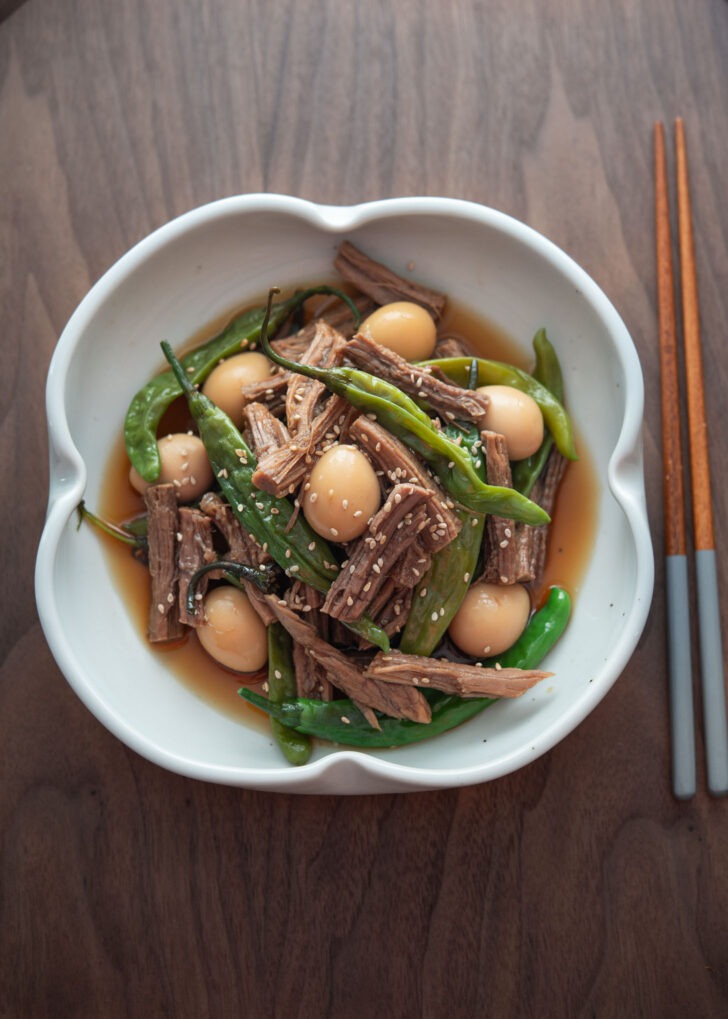
Growing up in South Korea, one of my most cherished banchan (Korean side dishes) was sogogi jangjorim – soy sauce braised beef. This popular side dish was a staple in the school lunch boxes of Korean children in days gone by.
The succulent beef, steeped in its flavorful broth, was such a hit with rice that I would easily polish off a bowl in no time.
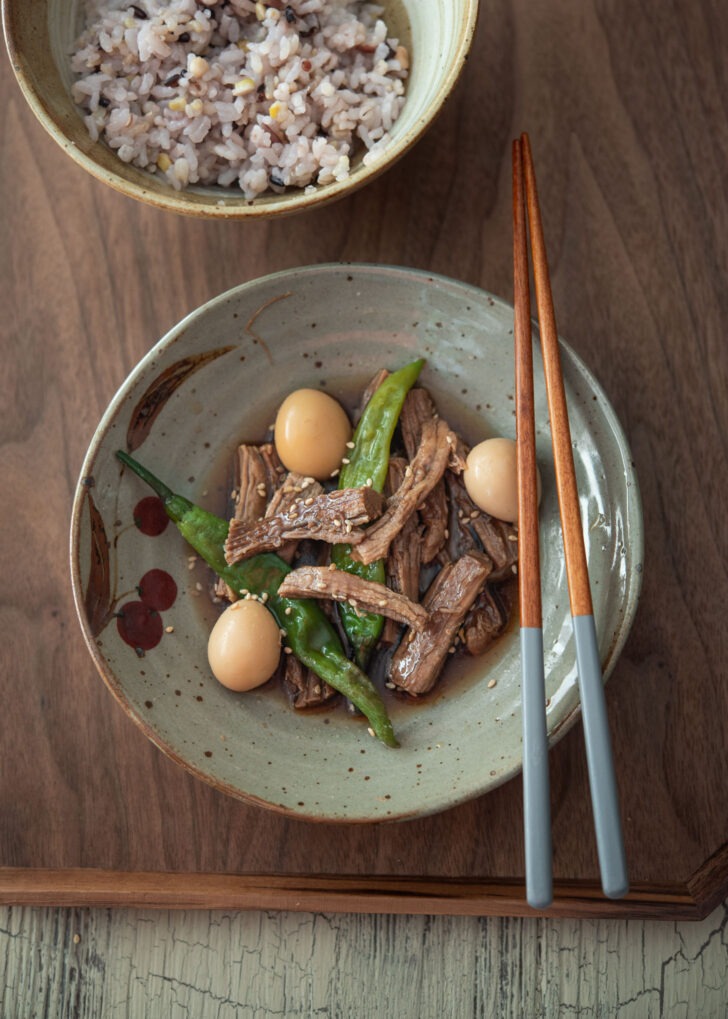
Whenever my mother prepared her jangjorim recipe, she would always include hard-boiled eggs, or quail eggs if they were on hand. Initially, I assumed that making this soy-braised beef would be intricate, but to my surprise, the process is rather straightforward.
While it’s a braising dish and thus demands time, using an instant pot can expedite the process. Personally, I prefer the old-fashioned stove-top method, as I believe it imparts a superior flavor.
What is Jangjorim?
Jangjorim is a traditional Korean side dish primarily made of beef that has been braised in soy sauce. This gently sweet and salty side dish often incorporates eggs or quail eggs, providing a protein-rich complement.
Many Koreans also add shishito peppers, locally known as Kkwari gochu, to the mix. The Jangjorim juice, the liquid that remains after braising, is a rich infusion of flavors, and it can enhance various other dishes.
Best Beef Cuts
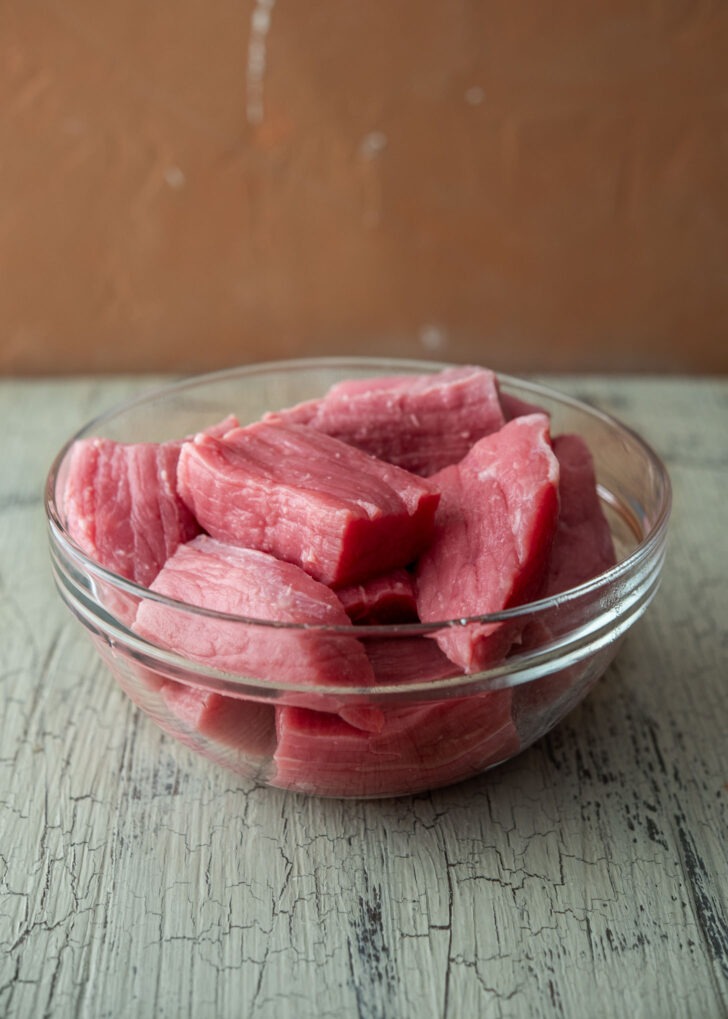
While the beef eye round (known as hongdukkaesal, 홍두깨살) is common choice for the recipe, others prefer brisket (yangjimeori, 양지머리), flank steak (chimatsal yangji, 치맛살 양지), or shank meat (satae, 사태).
These cuts tend to provide a richer flavor and superior texture. If you have a large piece of beef, cutting it into smaller blocks can reduce cooking time.
Pork Jangjorim: Opt for lean cuts like pork loin or tenderloin to create this Korean soy-braised dish as a beef alternative.
Ingredients notes
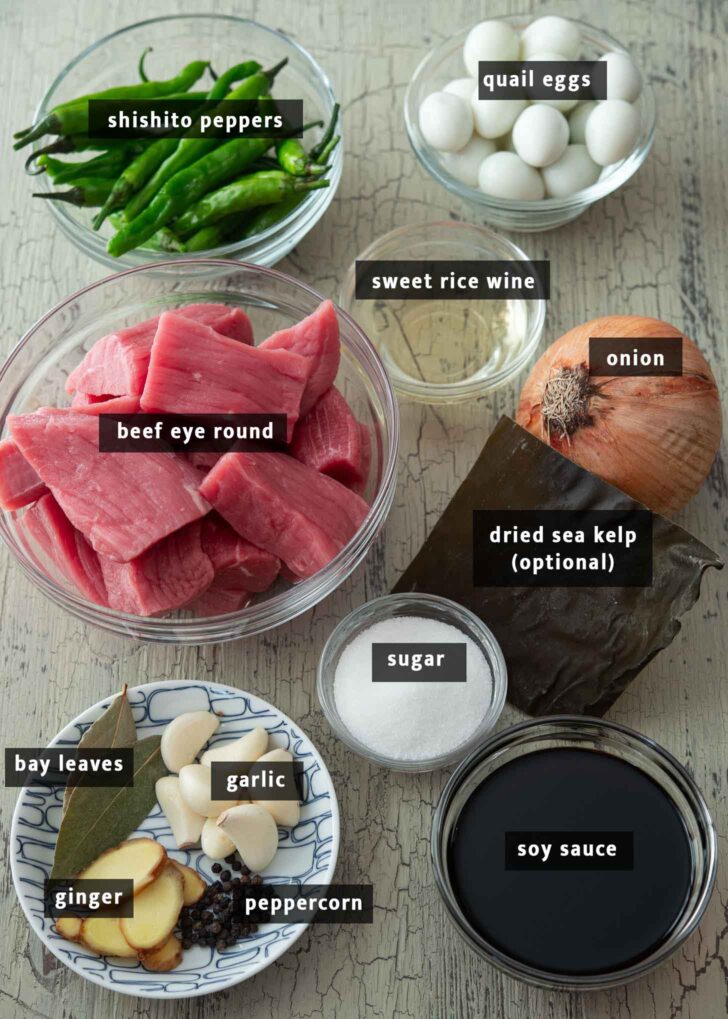
- Beef: Consider using eye round, brisket, or flank steak. Cut the meat into several chunks for easier cooking.
- Eggs: Either quail eggs or regular eggs work well. Use peeled hard-boiled eggs.
- Shishito Peppers: These are mild green chili peppers and are commonly available in many grocery stores.
- If you can’t find them, substitute with another fresh chili peppers or simply skip this ingredient.
- Aromatics: Ingredients like onion, garlic cloves, ginger slices, bay leaves, and whole black peppercorns are crucial to enhance the broth’s flavor.
- Soy Sauce: This essential ingredient seasons and infuses flavor into the beef.
- Sweet Rice Wine (Mirin): Adds depth to the braising liquid’s taste.
- Sugar: You can choose between white sugar and brown sugar based on your preference.
- Dried Sea Kelp (optional): This ingredient can introduce an extra layer of umami taste. If unavailable, it’s okay to omit.
How to Make Jangjorim
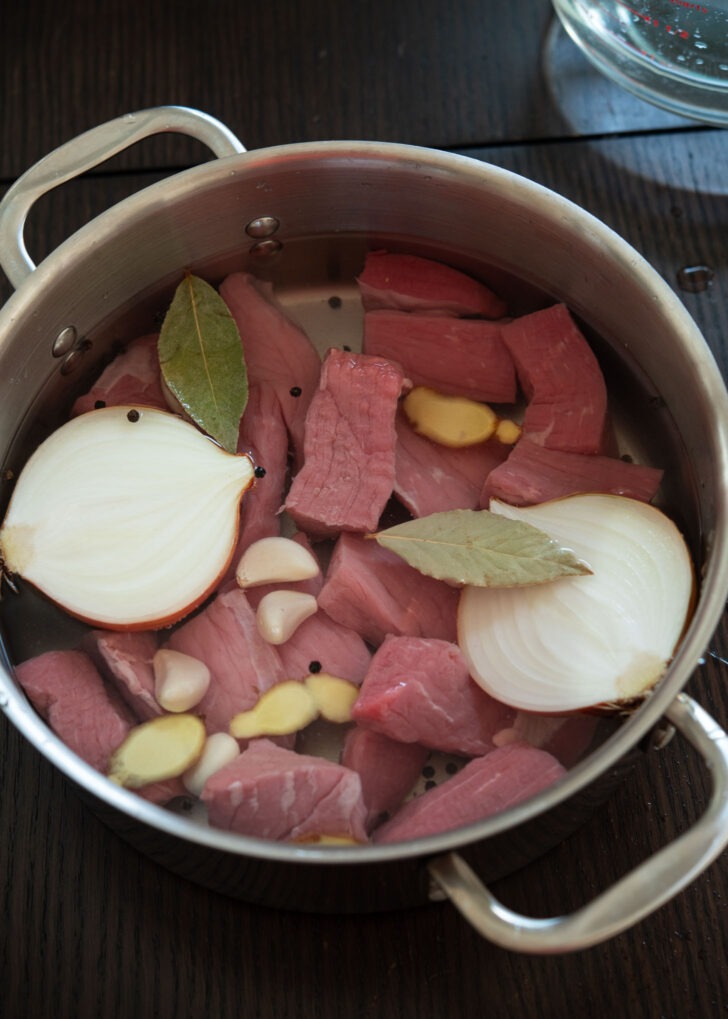
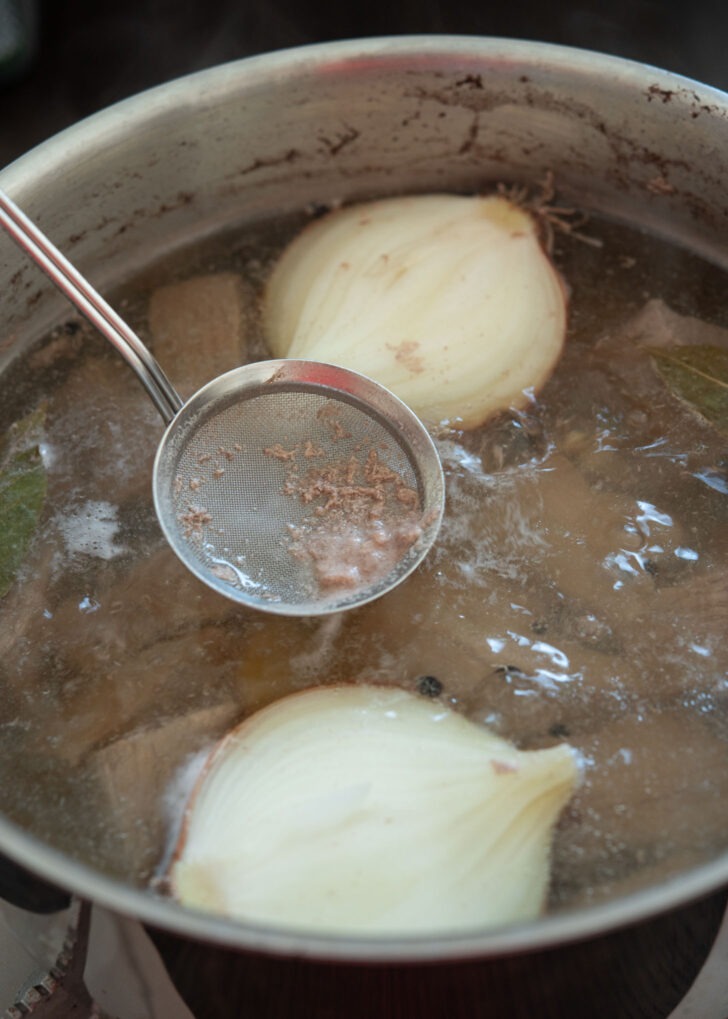
Step 1. Preparation of Beef Broth
- In a large pot, combine the small blocks of beef with aromatic vegetables such as onion, garlic cloves, ginger slices, bay leaves, and black peppercorns.
- Add 5-6 cups of cold water, ensuring the ingredients are fully submerged. Bring to a gentle boil.
- As it boils, skim off any foam or scum that rises to the surface.
- Lower the heat to medium and let it simmer for 30 minutes without a lid. This helps to reduce the gamey odor from the meat.
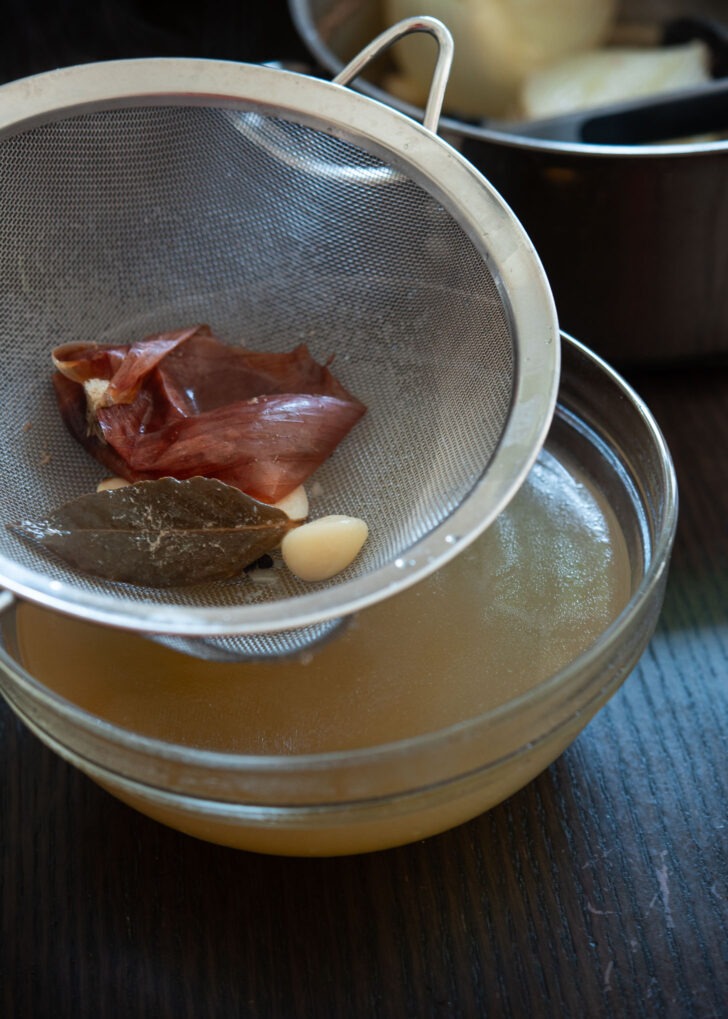
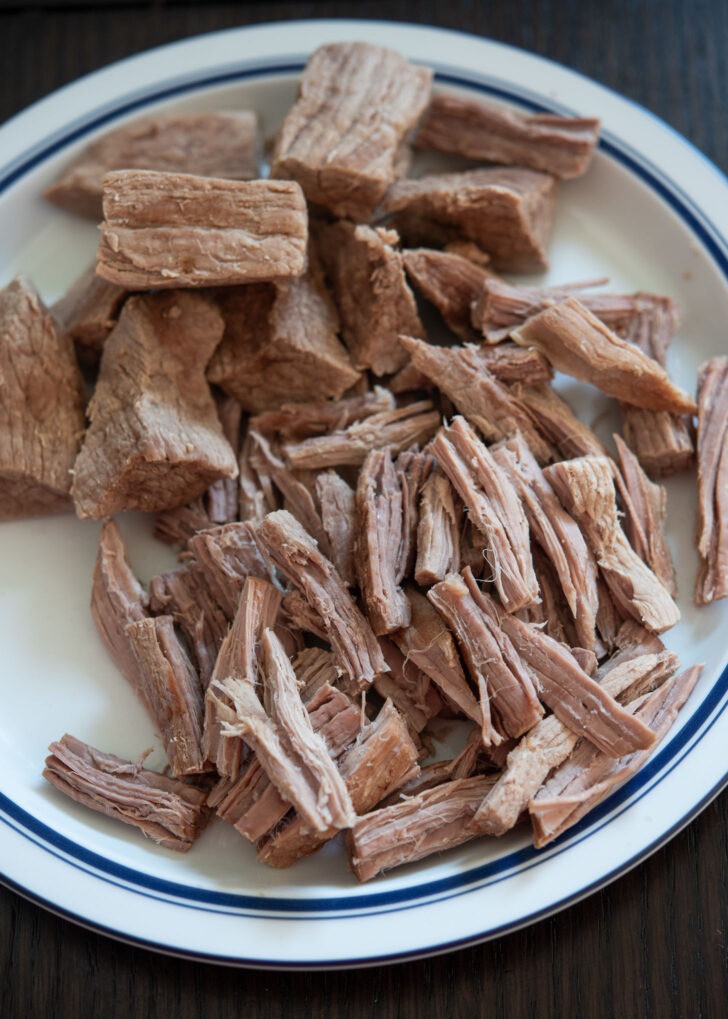
Step 2. Prepping the Meat
- Remove the meat from the pot and set it aside to cool.
- Strain the braising liquid over a large bowl or another pot, reserving about 3 cups. Discard the aromatic veggies.
- Save the remaining broth for Korean soups and other dishes.
- Once the beef has cooled for 5-10 minutes, either shred it into bite-sized pieces or slice into thin strips.
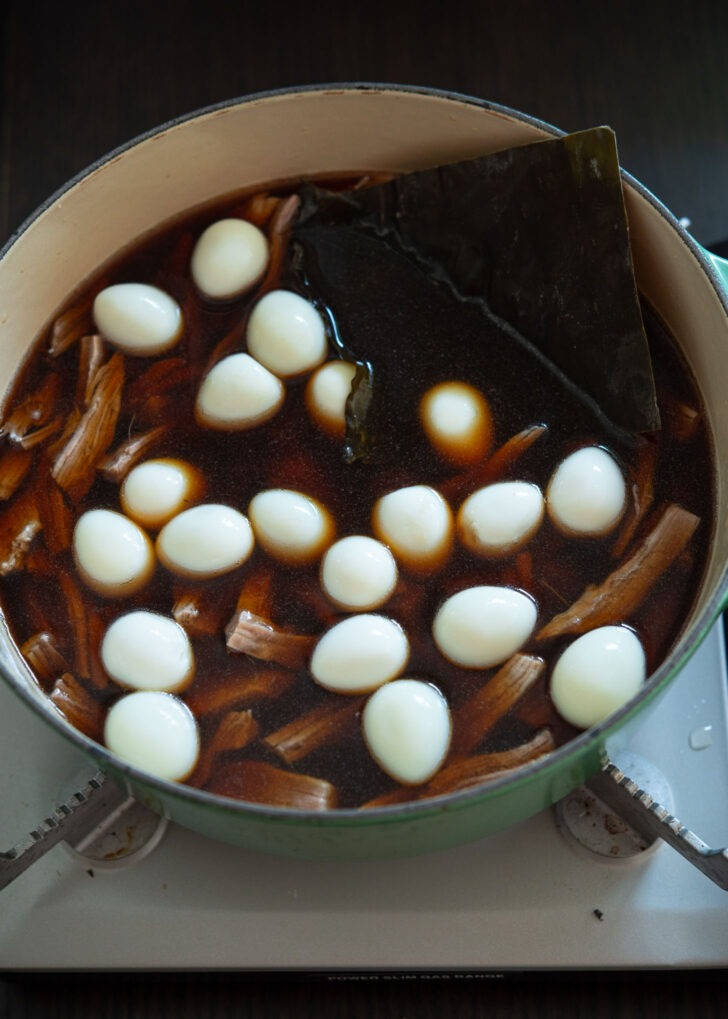
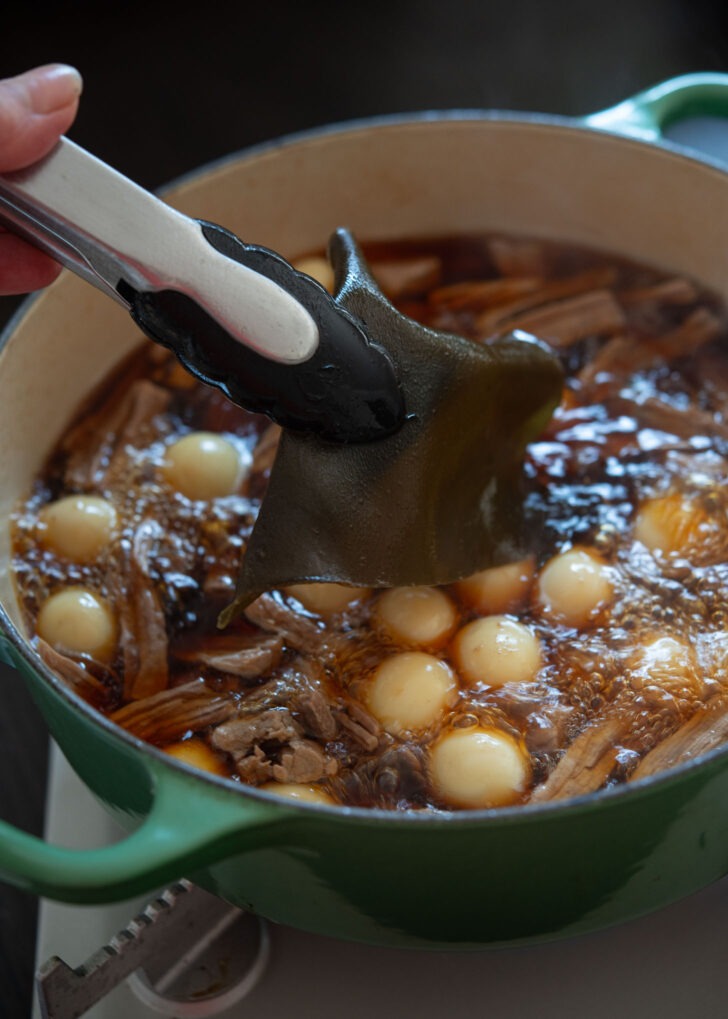
Step 3. Braising
- In a clean pot, combine the reserved broth, soy sauce, sweet rice wine, sugar, and, if using, a piece of dried sea kelp (dashima or kombu). Mix well.
- Add the shredded beef and quail eggs. Bring the mixture to a boil over medium heat for 15minutes, uncovered.
- Ensure you remove the sea kelp after boiling for 5 minutes.
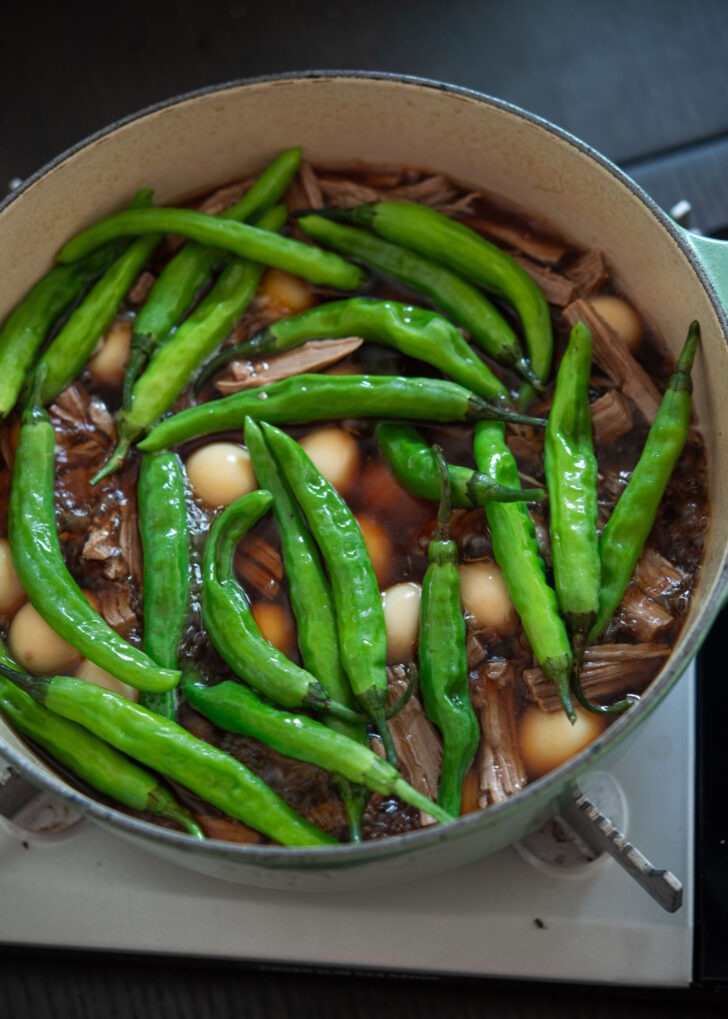
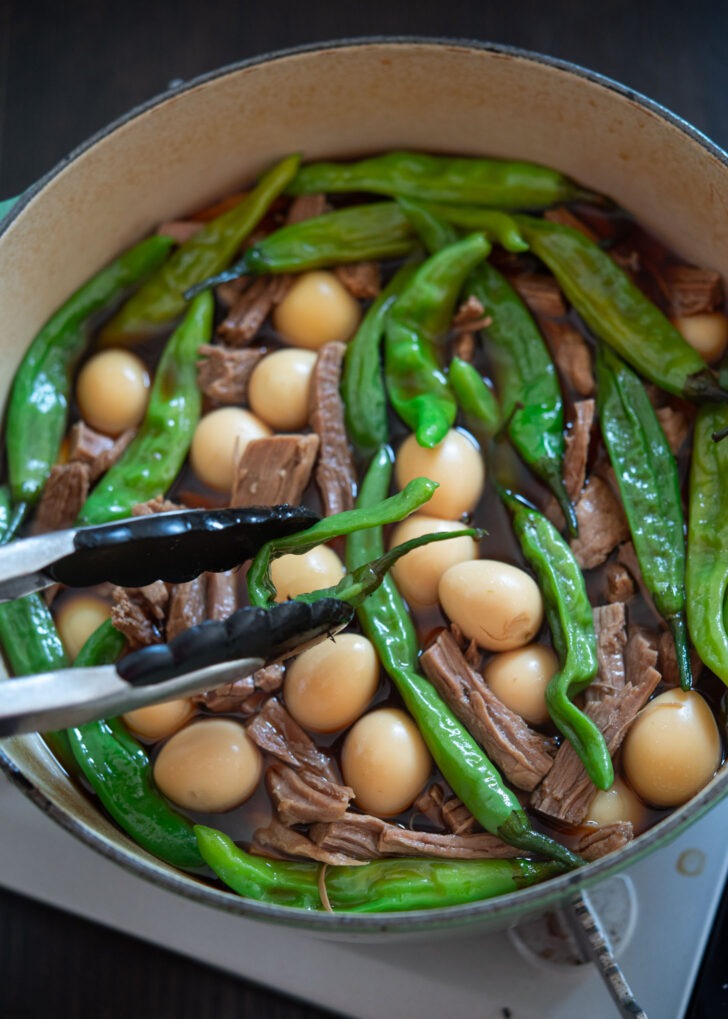
Step 4. Finishing Touches
- Incorporate the shishito peppers and let them cook for an additional 5-10 minutes, or until they’ve softened.
- Stir the mixture thoroughly and then allow it to cool to room temperature.
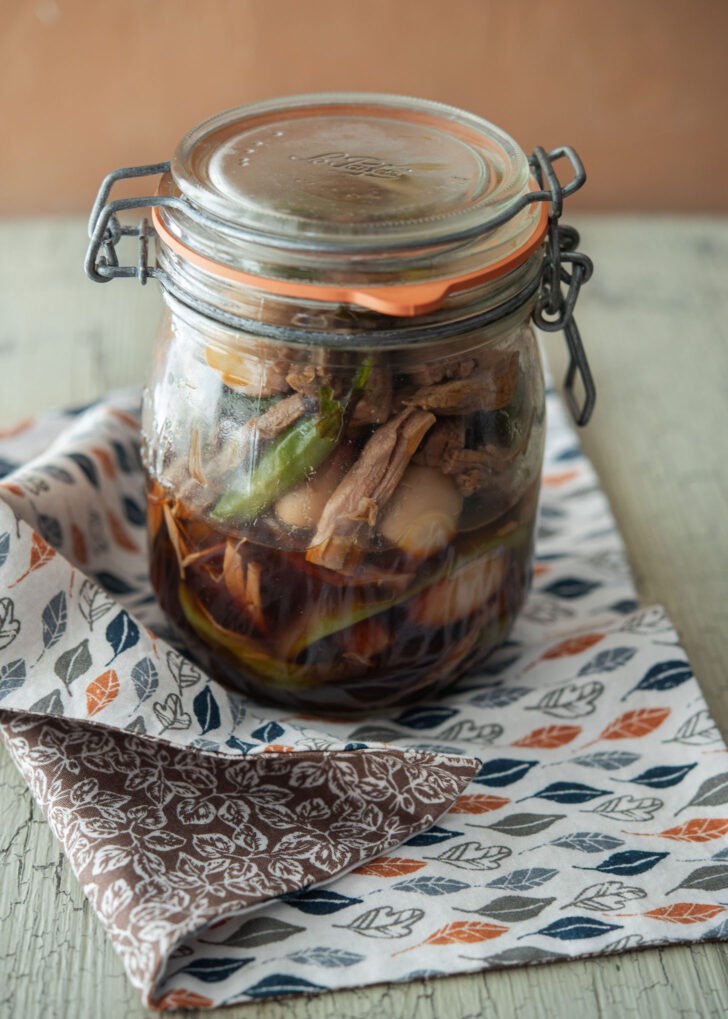
Storage Tips
Transfer the beef, eggs, and peppers into a clean glass container. Pour the sauce over. Always store the soy braised beef in the refrigerator.
On Fat
After chilling, you might see some oil floating on the sauce’s surface. This doesn’t compromise the flavor.
To minimize oil separation, place the sauce in the freezer after braising for several hours. The oil will solidify and rise to the top, making it easy to remove with a spoon. Alternatively, just before serving, a brief reheating in the microwave can melt the fat back into the dish.
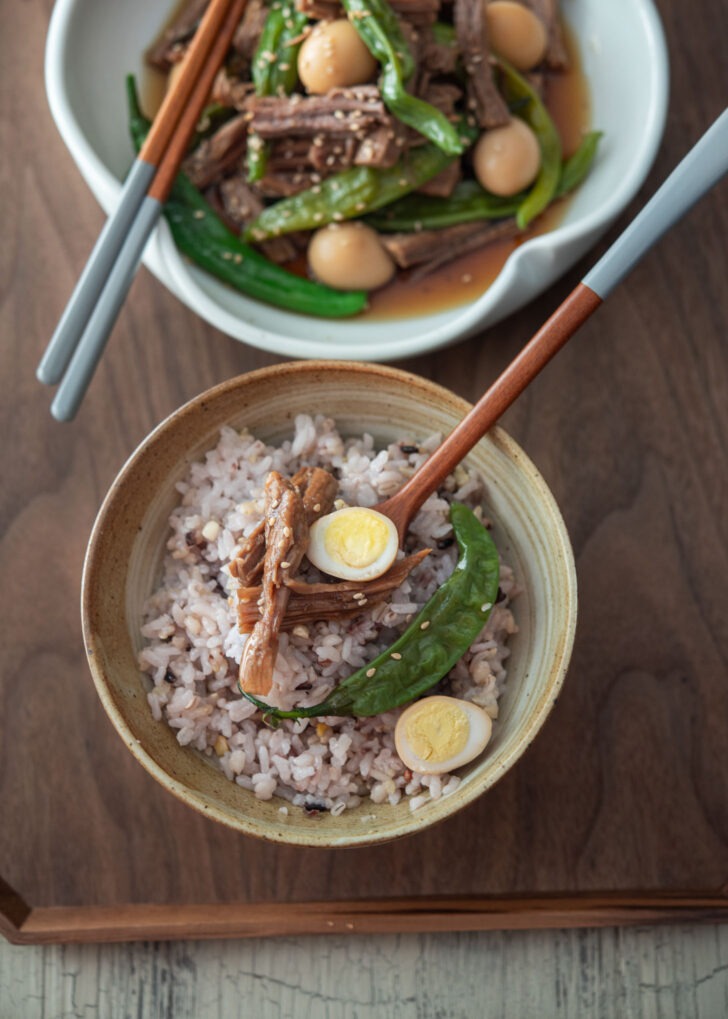
What to Eat with Jangjorim
Traditionally, this soy-braised beef is served as a banchan (side dish) alongside main Korean foods. Its slightly salty and sweet flavor complements a plain bowl of white rice or multigrain rice, making for a quick and a quick Korean meal. For those wanting some variety, it pairs wonderfully with vegetables or tofu.
When serving, plate up small portions of the meat and eggs, and ensure you drizzle them generously with the jangjorim juice. For an added depth of flavor, sprinkle some of this juice over the rice.
Jangjorim goes especially well with Korean soups and stews like Doenjang Jjigae, Kimchi Jjigae, Sundubu jJigae, and Kimchi Bean Sprout Soup. These hearty dishes can complete and elevate the entire meal.
How Long Does Jangjorim Last?
Jangjorim can be kept fresh in the refrigerator for up to two weeks, thanks to the preservative qualities of soy sauce. Storing it in an airtight container is crucial for maintaining its freshness.
The jangjorim juice, besides enhancing flavor, ensures the beef and eggs—whether in sogogi jangjorim or gyeran jangjorim—remain delectably fresh.

Related Recipes
- Gamja Jorim (Braised potato side dish)
- Galbi Jjim (Korean braised short ribs)
- Kimchi Jjim (Braised Kimchi and Pork Ribs)
- Braised Lotus Root (Yeongeun Jorim)
Originally published on April 19, 2011, this recipe has been updated with new images and additional information.
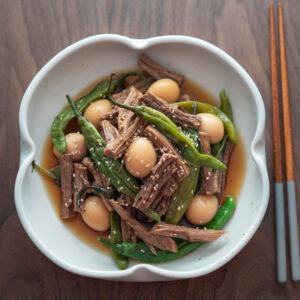
Jangjorim (Soy Braised Beef with Eggs)
Recipe Video
Ingredients
- 1 1/4 lb (560 g) beef eye round, brisket or flank steak, cut into 3-inch chunks
- 5 oz (150 g) quail eggs or 6 regular eggs, hard boiled and peeled
- 3 oz (85 g) shishito peppers, optional
For broth
- 1 medium onion, cut in half
- 7 cloves garlic
- 3 slices ginger
- 2 bay leaves
- 1 tsp black peppercorns
- 5-6 cups (1 liter) water
For sauce
- 1/2 cup (120 ml) soy sauce
- 1/4 cup (60 ml) sweet rice wine (mirim)
- 2-3 tbsp sugar
- 1 piece dried sea kelp (dashima), optional
Instructions
- In a large pot, combine the small blocks of beef with onion, garlic cloves, ginger slices, bay leaves, and black peppercorns. Add 5-6 cups of cold water, ensuring the ingredients are fully submerged. Bring to a gentle boil.
- As it boils, skim off any foam or scum that rises to the surface. Lower the heat to medium and let it simmer for 20 minutes without a lid. This helps to reduce the gamey odor from the meat.
- Remove the meat from the pot and set it aside to cool. Strain the braising liquid over a large bowl or another pot, reserving about 3 cups. Discard the aromatic veggies. Save the remaining broth for Korean soups and other dishes.
- Once the beef has cooled for 5-10 minutes, either shred it into bite-sized pieces or slice into thin strips.
- In a clean pot, combine the reserved broth, soy sauce, sweet rice wine, sugar, and, if using, a piece of dried sea kelp (dashima or kombu). Mix well. Add the shredded beef and quail eggs. Bring the mixture to a boil over medium heat for 15 minutes, uncovered. Ensure you remove the sea kelp after boiling for 5 minutes.
- Incorporate the shishito peppers and let them cook for an additional 5-10 minutes, or until they've softened. Stir the mixture thoroughly and then allow it to cool to room temperature.
- To store: Transfer the beef, eggs, and peppers into a clean glass container. Pour the sauce over, ensuring all ingredients are fully submerged. Always store it in the refrigerator.


This sounds so delicious! Can’t wait to try it. Quick question — We bought half a cow from a local rancher this year. I have several cuts of beef eye round that are 1/2 pound. Do you think I could I use three of them? Would I need to modify the cooking time? Thanks!
Eye round is perfect for this particular beef dish. I use it all the time.
What is the name of the brand for that Korean Rice Wine?
Is this the same recipe when Koreans also put hard boiled egg along with the beef? My MIL makes something like this but she also puts hard boiled eggs which are delicious.
Yes, it is. You can add the hard boiled egg along with the beef.
Thanks Christina. I am happy that you found many recipes you grow up with. Hope you can try some soon.
I LOVE your site, and every single recipe here. I am so grateful–there are foods that I have yet to find in cookbooks, that I grew up with. Thank you for sharing! I've been clicking all over your site, and bookmarking so many recipes.
You're welcome. I am glad you like it.
Fabulous! We had it as a main course with rice. Loved the flavors.
Beef and spices. This is like the perfect recipe! It is delicious! Thanks for sharing!
This looks great! I have never had this side dish, usually I get kimchi or spicy potatos as side dishes when I visit a Korean restaurant. I am sure I will give this recipe a try sooner or later, it looks too good to miss! Thanks for sharing this wonderful recipe :).
Yup, that's how I usually enjoy. So good together.
Jenn
I am glad that you mentioned about the ratio. I totally forgot to add the
amount of Korean soy sauce (gook-ganjang) in the recipe. I fixed it and it
should be on the post.
I would not recommend Chinese soy sauce in any Korean recipe since it has
very different flavor. Kikkoman is, however, great to substitute for regular
soy sauce (not the Korean style, gook-ganjang soy sauce).
I know it sounds confusing but Koreans use two types of soy sauce. One is
just regular typical soy sauce that most people use, like Kikkoman.
And the other is called goo-ganjang, the Korean style soy sauce. It is
thinner and saltier. You can sub with 1/2 amount of fish sauce if you can't
find it.
Hope this helps.
jangjorim reminds me of my mom. She'd always make it and bring a batch for me when I was in college. Your recipe for it looks so delicious and clean. Yeah I always hated that it would congeal with fat particles when chilled…gross. But nothing beats jangjorim, rice and kimchi!
julie
Thanks for the recipe. What ratio do you recommend for Korean soy sauce and (regular?) soy sauce? Also, would Chinese dark soy sauce substitute well for Korean soy sauce? Is Kikkoman soy sauce acceptable for the regular soy sauce? Thanks.